Response of Potential Evapotranspiration to Warming and Wetting in Northwest China
Abstract
:1. Introduction
2. Materials and Methods
2.1. Materials
2.2. Methods
2.2.1. Calculation of PET
2.2.2. Factor Effect Analysis of PET
2.2.3. Statistical Analysis
2.2.4. Index of Aridity
2.2.5. Climate Trend Coefficient
3. Results
3.1. Spatial Distribution and Trend of PET in Northwest China
3.1.1. Spatial Distribution of PET in Northwest China
3.1.2. Characteristics of PET in Northwest China
3.1.3. Characteristics of Variation in PET Climate Trend Coefficient with Altitude in Northwest China
3.2. Response of PET to Warming and Wetting
3.2.1. Response of PET to Highest and Lowest Temperatures
3.2.2. Response of PET to Humidity
3.2.3. Response of PET to Sunshine Duration
3.2.4. Response of PET to Wind Speed
3.2.5. Actual Changes in PET in Northwest China and Their Contribution Factors
4. Discussion
4.1. Comparison of Actual Changes and Factor Analysis Results of PET in Northwest China from 2010 to 2019
4.2. Uncertainties and Limitations
5. Conclusions
- (1)
- By analyzing the spatial distribution of PET and climate change trends in Northwest China in the past sixty years, this study revealed that the changes in both PET and the warming and wetting in Northwest China were clearly regional and periodic. In the periods 1961–1990 and 1971–2000, PET mainly decreased; in the periods 1981–2010 and 1991–2019, the trend was opposite, especially during 1981–2010, when the climate trend coefficient of PET was, on average, between 0.2 and 0.4. From 1971–2000 to 1981–2010, the change in the climate trend of PET was the most significant.
- (2)
- This study analyzed the response of PET to warming and wetting in Northwest China using the factor analysis method and the 1961–1970 period as the reference. It was found that PET increased and responded positively to the temperature. A rapid increase mainly occurred in the 1990s, corresponding well with the highest and lowest temperatures changes. Relative humidity increased significantly in the humid zones and decreased significantly in the semi-arid zones, leading to a continued decrease in overall PET in the region, especially in the humid zone; however, the magnitude of PET decrease was generally not large, and it gradually rebounded in the last three decades. The amount of sunshine duration has continued to decline rapidly since the 1980s, especially in humid and arid zones, leading to a corresponding decrease in PET in the region. Similarly, as the wind speed decreased in the region, PET also decreased significantly; the largest magnitude of decrease was in the arid zone, followed by the humid zone.
- (3)
- Temperature is the only factor that has caused PET to increase; changes in all the other meteorological factors have reduced PET in Northwest China. However, the most significant changes in overall PET in this region occurred in the 1970s and 1980s. In general, PET in the humid climate zone has decreased significantly, while that in the semi-arid climate zone has increased.
- (4)
- PET in the central and eastern parts of Northwest China was mainly affected by the temperature. As the wind speed is high throughout the year in the western part of this region, it has also been a major factor affecting PET. The impacts of relative humidity and sunshine duration have been relatively small (below 20% in most places).
Supplementary Materials
Author Contributions
Funding
Institutional Review Board Statement
Informed Consent Statement
Data Availability Statement
Acknowledgments
Conflicts of Interest
References
- Ding, Y.; Wang, S.; Zheng, J.; Wang, H.; Yang, X. Chinese Climate, 1st ed.; Science Press: Beijing, China, 2013; pp. 49–51. [Google Scholar]
- Ding, Y.; Zhang, L. Intercomparis on of the time for climate abrupt change between the Tibetan Plateau and other regions in China. Chin. J. Atmos. Sci. 2008, 32, 794–805. [Google Scholar]
- Zhang, M.; Yu, H.; Huang, J.; Wei, Y.; Zhang, T. Comparison of extreme temperature response to 0.5 °C additional warming between dry and humid regions over East-Central Asia. Int. J. Climatol. 2019, 39, 3348–3364. [Google Scholar] [CrossRef]
- Zhang, M.; Yu, H.; King, A.; Wei, Y.; Huang, J.; Ren, Y. Greater probability of extreme precipitation under 1.5 °C and 2 °C warming limits over East-Central Asia. Clim. Change 2020, 162, 603–619. [Google Scholar] [CrossRef]
- Lu, S.; Hu, Z.; Yu, H.; Fan, W.; Fu, C.; Wu, D. Changes of extreme precipitation and its associated mechanisms in Northwest China. Adv. Atmos. Sci. 2021, 38, 1665–1681. [Google Scholar] [CrossRef]
- Zhang, Z.; Kang, J.; Wang, S.; Zuo, H.; Wei, G. Atmospheric Circulation and Water Vapor Characteristics of the Precipitation Anomaly in Eastern Part of Northwest China. Desert Oasis Meteorol. 2019, 13, 87–92. [Google Scholar] [CrossRef]
- Yang, J.; Jin, R.; Liu, X. Inter-seasonal distribution pattern of rainy season precipitation in the east region of northwest China. Arid. Land Geogr. 2017, 40, 21–29. [Google Scholar] [CrossRef]
- Zhang, Q.; Lin, J.; Liu, W.; Han, L. Precipitation seesaw phenomenon and its formation mechanism in the eastern and western parts of Northwest China during flood season. Sci. China Earth Sci. 2019, 62, 2083–2098. [Google Scholar] [CrossRef]
- Zhu, X.; Sun, Y.; Tan, Z.; Liu, J. The Variation Characteristics of Somali Cross-Equatorial Flow (SML) and Its Impact on Summer Precipitation in the East of Northwest China. Desert Oasis Meteorol. 2019, 13, 7–12. [Google Scholar] [CrossRef]
- Xu, D.; Kong, Y.; Wang, C. Changes of Water Vapor Budget in Arid Area of Northwest China and Its Relationship with Precipitation. J. Arid. Meteorol. 2016, 34, 431–439. [Google Scholar]
- Fan, G.; Cheng, G. Reason Analysis of the Influence of Qinghai-Xizang Plateau Uplifting on Arid Climate Forming in Northwest China (I): Influence on General Circulation of Atmosphere. Plateau Meteorol. 2003, 22, 45–57. [Google Scholar]
- Fan, G.; Cheng, G. Simulation of Influence of Qinghai-Xizang Plateau Uplifting on NW China Arid Climate Forming (II):Changing of atmosphere hydrological cycle and Dynamical and Thermal Effects of Plateau. Plateau Meteorol. 2003, 22, 58–66. [Google Scholar]
- Xia, X.; Ren, R.; Wu, G. An analysis on the spatio-temporal variations and dynamic effects of the tropopause and the related stratosphere-troposphere coupling surrounding the Tibetan Plateau area. Acta Meteorol. Sin. 2016, 74, 525–541. [Google Scholar]
- Ren, G.; Yuan, Y.; Liu, Y.; Ren, Y.; Wang, T.; Ren, X. Changes in Precipitation over Northwest China. Arid. Zone Res. 2016, 33, 1–19. [Google Scholar] [CrossRef]
- Shi, Y.; Shen, Y.; Li, D.; Zhang, G.; Ding, Y.; Hu, R.; Kang, E. Discussion on the present climate change from warm-dry to warm-wet in northwest china. Quat. Sci. 2003, 23, 152–164. [Google Scholar]
- Yang, B.; Qin, C.; Wang, J.; Min, H.; Melvin, T.M.; Osborn, T.J.; Briffa, K.R. A 3500-year tree-ring record of annual precipitation on the northeastern Tibetan Plateau. Proc. Natl. Acad. Sci. USA 2014, 111, 2903–2908. [Google Scholar] [CrossRef] [PubMed] [Green Version]
- Shi, Y.; Yao, T.; Yang, B. Decadal climatic variations recorded in Guliya ice core and comparison with historical documentary data from East China during the last 2000 years. Sci. China Ser. D 1999, 42, 303–312. [Google Scholar] [CrossRef]
- Shi, Y.; Shen, Y. Signal, Impact and Outlook of Climatic Shift from Warm-Dry to Warm- Humid in Northwest China. Sci. Technol. Rev. 2003, 2, 54–57. [Google Scholar]
- Zhang, Q.; Zhu, B.; Yang, J.; Ma, P.; Liu, X.; Lu, G.; Wang, Y.; Yu, H.; Wang, D.; Liu, W. New characteristics about the climate humidification trend in Northwest China. Chin. Sci. Bull. 2021, 66, 3757–3771. [Google Scholar] [CrossRef]
- Hulme, M. Recent climatic change in the world’s drylands. Geophys. Res. Lett. 1996, 23, 61–64. [Google Scholar] [CrossRef]
- Allen, R.J.; Anderson, R.G. 21st century California drought risk linked to model fidelity of the El Niño teleconnection. Clim. Atmos. Sci. 2018, 1, 21. [Google Scholar] [CrossRef]
- Huang, J.; Li, Y.; Fu, C.; Chen, F.; Fu, Q.; Dai, A.; Shinoda, M.; Ma, Z.; Guo, W.; Li, Z.; et al. Dryland climate change: Recent progress and challenges. Rev. Geophys. 2017, 55, 719–778. [Google Scholar] [CrossRef]
- Greve, P.; Orlowsky, B.; Mueller, B.; Sheffield, J.; Reichstein, M.; Seneviratne, S. Global assessment of trends in wetting and drying over land. Nat. Geosci. 2014, 7, 716–721. [Google Scholar] [CrossRef]
- Trenberth, K.E.; Dai, A.; van der Schrier, G. Global warming and changes in drought. Nat. Clim. Change 2014, 4, 17–22. [Google Scholar] [CrossRef]
- Mishra, A.K.; Singh, V.P. A review of drought concepts. J. Hydrol. 2010, 391, 202–216. [Google Scholar] [CrossRef]
- Dai, A.; Zhao, T. Uncertainties in historical changes and future projections of drought. Part I: Estimates of historical drought changes. Clim. Change 2016, 144, 519–533. [Google Scholar] [CrossRef]
- Prudhomme, C.; Giuntoli, I.; Robinson, E.L.; Clark, D.B.; Arnell, N.W.; Dankers, R.; Fekete, B.M.; Franssen, W.; Gerten, D.; Gosling, S.N. Hydrological droughts in the 21st century, hotspots and uncertainties from a global multimodel ensemble experiment. Proc. Natl. Acad. Sci. USA 2013, 111, 3262–3267. [Google Scholar] [CrossRef] [PubMed] [Green Version]
- Zhang, Q.; Zhang, L.; Huang, J.; Zhang, L.; Wang, W.; Sha, S. Spatial distribution of surface energy fluxes over the Loess Plateau in China and its relationship with climate and the environment. Sci. China Earth Sci. 2014, 57, 2135–2147. [Google Scholar] [CrossRef]
- Sentelhas, P.C.; Gillespie, T.J.; Santos, E.A. Evaluation of FAO Penman-Monteith and alternative methods for estimating reference evapotranspiration with missing data in Southern Ontario, Canada. Agric. Water Manag. 2010, 97, 635–644. [Google Scholar] [CrossRef]
- Ma, Z.; Hua, L.; Ren, X. The extreme dry/wet events in northern China During Recent 100 years. Acta Geogr. Sin. 2003, 58, 69–74. [Google Scholar]
- Shahzada, A.; Kalim, U.; Azmat, H.; Gao, S. Meteorological impacts on evapotranspiration in different climatic zones of Pakistan. J.Arid Land 2017, 9, 938–952. [Google Scholar]
- Moran, M.S.; Rahman, A.F.; Washburne, J.C.; Goodrich, D.C.; Weltz, M.A.; Kustas, W.P. Combining the Penman-Monteith equation with measurements of surface temperature and reflectance to estimate evaporation rates of semiarid grassland. Agric. For. Meteorol. 1996, 80, 87–109. [Google Scholar] [CrossRef]
- Langensiepen, M.; Fuchs, M.; Bergamaschi, H.; Moreshet, S.; Cohen, Y.; Wolff, P.; Jutzi, S.C.; Cohen, S.; Rosa, L.M.G.; Yan, L.; et al. Quantifying the uncertainties of transpiration calculations with the Penman-Monteith equation under different climate and optimum water supply conditions. Agric. For. Meteorol. 2009, 149, 1063–1072. [Google Scholar] [CrossRef]
- Zhou, X.; Zhu, Q.; Sun, Z.; Sun, R. Preliminary study on regionalization desertification climate in China. J. Nat. Disasters 2002, 11, 125–131. [Google Scholar]
- Yu, Z.; Zhou, W.; Zhang, X. An Attribution Analysis Of Changes In Potential Evapotranspiration In The Beijing-Tianjin-Hebei Region Under Climate Change. J. Trop. Meteorol. 2019, 25, 82–91. [Google Scholar]
- Gao, Y.; Zhao, C.; Muhammad, W.; Ashiq, M.; Wang, Q.; Rong, Z.; Liu, J.; Mao, Y.; Guo, Z.; Wang, W. Actual evapotranspiration of subalpine meadows in the Qilian Mountains, Northwest China. J. Arid Land 2019, 11, 371–384. [Google Scholar] [CrossRef] [Green Version]
- Cao, W.; Shen, S.; Duan, C. Temporal-spatial variations of potential evapotranspiration and quantification of the causes in Northwest China. Acta Ecol. Sin. 2012, 32, 3394–3403. [Google Scholar] [CrossRef]
- Huang, X.; Zhang, M.; Jia, W.; Wang, S.; Zhang, N. Variations of surface humidity and its influential factors in Northwest China. Adv. Water Sci. 2011, 22, 151–159. [Google Scholar] [CrossRef]
- Zhang, Q.; Wang, W.; Wang, S.; Zhang, L. Increasing Trend of Pan Evaporation over the Semiarid Loess Plateau under a Warming Climate. J. Appl. Meteorol. Climatol. 2008, 55, 2007–2020. [Google Scholar] [CrossRef]
- Yang, S.; Zhang, Q.; Xi, X.; Qiao, L. Comparative analysis of pan evaporation trends between the summer monsoon transition region and other regions of China. Plateau Meteorol. 2018, 37, 1017–1024. [Google Scholar] [CrossRef]
- Li, Q.; Dong, W.; Li, W.; Gao, X.; Jones, P.; Kennedy, J.; Parker, D. Assessment of the uncertainties in temperature change in China during the lastcentury. China Sci. Bull 2010, 55, 1544–1554. (In Chinese) [Google Scholar]
- Yang, S.; Li, Q. Improvement in homogeneity analysis method and updata of China precipitation data. Clim. Change Res. 2014, 10, 276–281. (In Chinese) [Google Scholar]
- Cai, J.; Liu, Y.; Lei, T.; Luis, S. Estimating reference evapotranspiration with the FAO Penman–Monteith equation using daily weather forecast messages. Agric. For. Meteorol. 2007, 145, 22–35. [Google Scholar] [CrossRef]
- The State Standard of the People’s Republic of China; Classification of meteorological drought (GB/T 20481-2017); Standards Press of China: Beijing, China, 2017.
- Gao, G.; Chen, D.; Ren, G.; Chen, Y.; Liao, Y. Trend of potential evapotranspiration over China during 1956 to 2000. Geogr. Res. 2006, 25, 378–387. [Google Scholar]
- Fu, Q.; Feng, S. Responses of terrestrial aridity to global warming. J. Geophys. Res. Atmos. 2014, 119, 7863–7875. [Google Scholar] [CrossRef]
- Tang, H.; Zhai, P.; Wang, Z. On Change in Mean Maximum Temperature, Minimum Temperature and Diurnal Range in China During 1951–2002. Clim. Environ. Res. 2005, 10, 728–735. [Google Scholar]
- Wang, L.; Xie, X.; Su, W.; Guo, X. Changes of maximum and minimum temperature and their impacts in northern China over the second half of the 20th century. J. Nat. Resour. 2004, 19, 337–343. [Google Scholar]
- Huang, J.; Zhang, W.; Zuo, J.; Bi, J.; Shi, J.; Wang, X.; Chang, Z.; Huang, Z.; Yang, S.; Zhang, B. An overview of the semi-arid climate and environment research observatory over the Loess Plateau. Adv. Atmos. Sci. 2008, 25, 906–921. [Google Scholar] [CrossRef]
- Zhang, Q.; Qiao, L.; Yue, P.; Li, Y. The energy mechanism controlling the continuous development of a super-thick atmospheric convective boundary layer during continuous summer sunny periods in an arid area. Chin. Sci. Bull. 2019, 64, 1637–1650. (In Chinese) [Google Scholar] [CrossRef] [Green Version]
- Zhao, J.; Zhang, Q.; Wang, S. A simulative study of the thermal mechanism for development of the convective boundary layer in the arid zone of northwest China. Acta Meteorol. Sinica 2011, 69, 1029–1037. [Google Scholar]
- Zhang, Q.; Zhao, Y.; Wang, S.; Ma, F. A study on atmospheric thermal boundary layer structure in extremely arid desert and gobi region on the clearday in summer. Adv. Earth Sci. 2007, 22, 1150–1159. (In Chinese) [Google Scholar]
- Yao, T.; Xue, Y.; Chen, D.; Chen, F.; Thompson, L.; Cui, P.; Koike, T.; Lau, K.; Lettenmaier, D.; Mosbrugger, V. Recent Third Pole’s rapid warming accompanies cryospheric melt and water cycle intensification and interactions between monsoon and environment: Multidisciplinary approach with observations, modeling, and analysis. Bull. Am. Meteorol. Soc. 2019, 100, 423–444. [Google Scholar] [CrossRef]
- Tang, Q.; Lan, C.; Su, F.; Liu, X.; Sun, H.; Ding, J.; Wang, L.; Leng, G.; Zhang, Y.; Sang, Y. Streamflow change on the Qinghai-Tibet Plateau and its impacts. Chin. Sci. Bull. 2019, 64, 2807–2821. [Google Scholar]
- Sun, M.; Liu, S.; Yao, X.; Guo, W.; Xu, J. Glacier changes in the Qilian Mountains in the past half-century: Based on the revised First and Second Chinese Glacier Inventory. J. Geogr. Sci. 2018, 28, 206–220. [Google Scholar] [CrossRef] [Green Version]
- Ding, Y.; Liu, S.; Li, J.; Shangguan, D. The retreat of glaciers in response to recent climate warming in western China. Ann. Glaciol. 2006, 43, 97–105. [Google Scholar] [CrossRef] [Green Version]
- Kang, S.; Guo, W.; Wu, T.; Zhong, X.; Chen, R.; Xu, M.; Chen, J.; Yang, R. Cryo-spheric changes and their impacts on water resources in the Beltand Road Regions. Adv. Earth Sci. 2020, 35, 1–17. [Google Scholar]
- Ding, Y. Climate Change Research over China-Science, Impact, Adaptation and Strategy Policy, 1st ed.; China Environmental Press: Beijing, China, 2009; pp. 90–91. [Google Scholar]
- Wang, K.; Jiang, H.; Zhao, H. Atmospheric water vapor transport from westerly and monsoon over the Northwest China. Adv. Water Sci. 2005, 16, 432–438. (In Chinese) [Google Scholar]
- Wang, H.; Fan, K. Recent changes in the East Asian monsoon. Chin. J. Atmos. Sci. 2013, 37, 313–318. (In Chinese) [Google Scholar]
- Fang, G.; Li, X.; Xu, M.; Wen, X.; Huang, X. Spatiotemporal Variability of Drought and Its Multi-Scale Linkages with Climate Indices in the Huaihe River Basin, Central China and East China. Atmosphere 2021, 12, 1446. [Google Scholar] [CrossRef]
- Zhang, Q. Scientific View of the Phenomenon of Warming and Humidification in the Northwest. China Meteorological News, 15 January 2020. [Google Scholar]
- Wang, C.; Zhang, S.; Zhang, F.; Li, K.; Yang, K. On the increase of precipitation in the Northwestern China under the global warming. Adv. Earth Sci. 2021, 36, 980–989. [Google Scholar] [CrossRef]
- Ghaderpour, E. Least-squares Wavelet and Cross-wavelet Analyses of VLBI Baseline Length and Temperature Time Series: Fortaleza–Hartebeesthoek–Westford–Wettzell. Publ. Astron. Soc. Pacifific 2021, 133, 014502. [Google Scholar] [CrossRef]

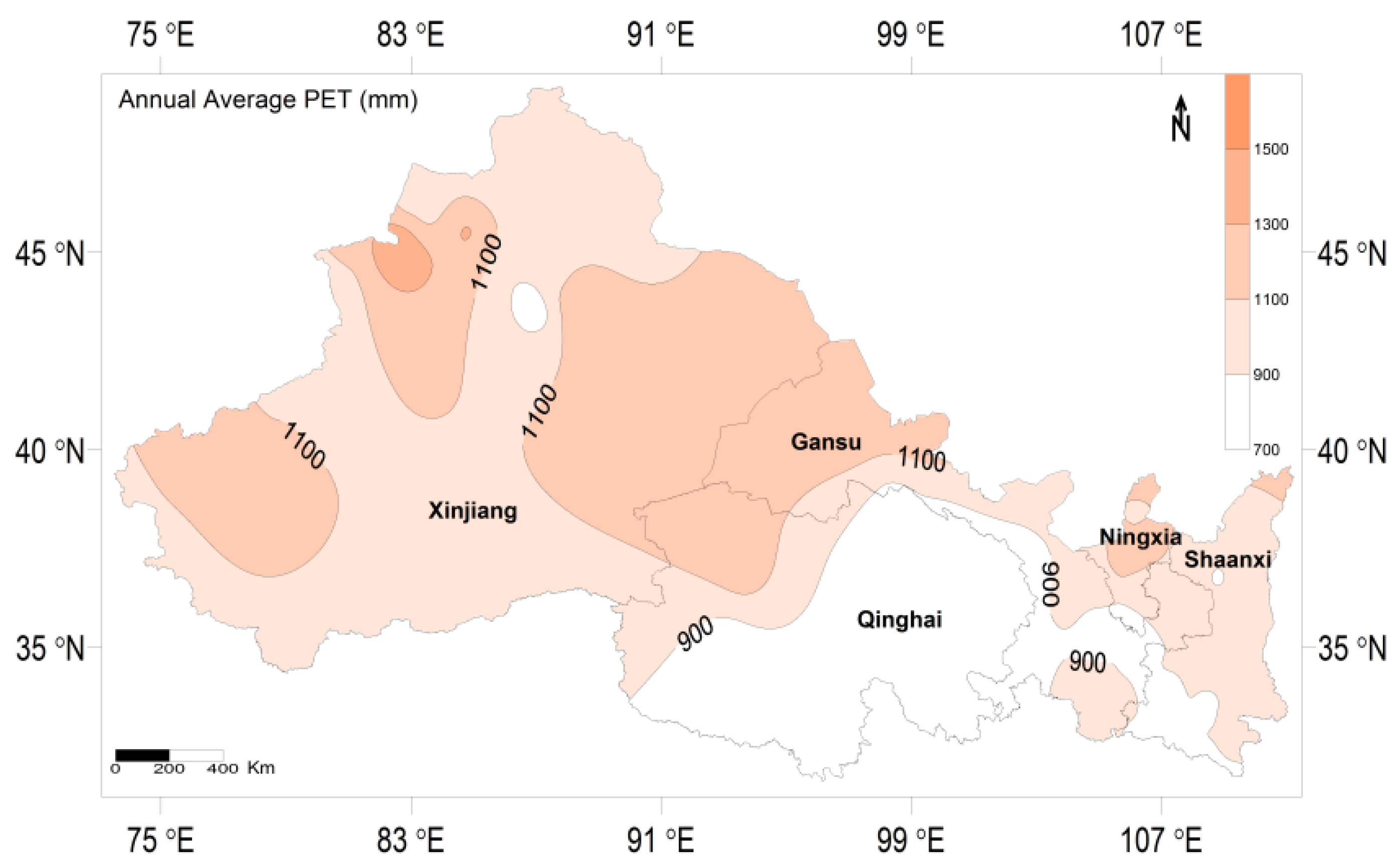
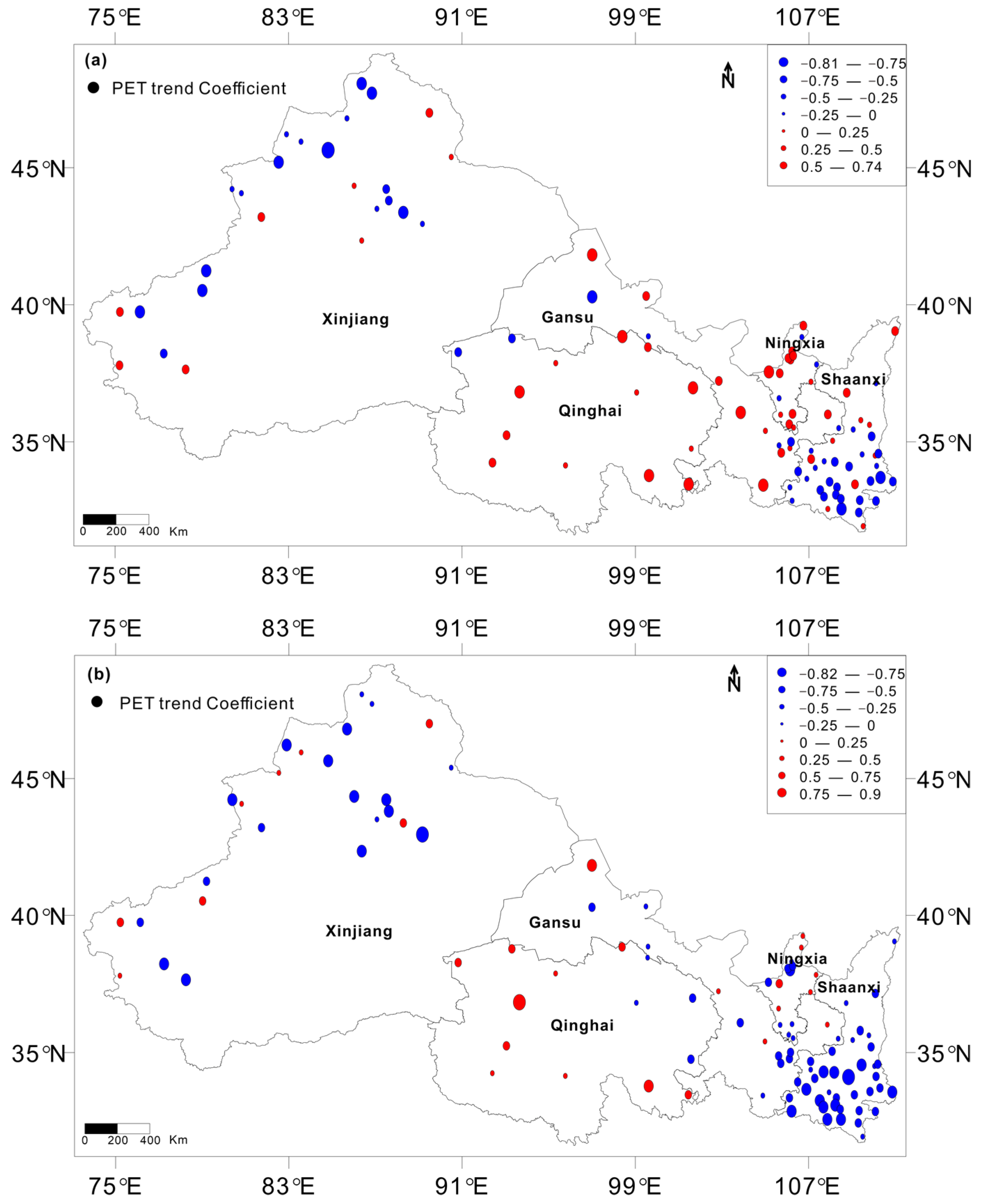
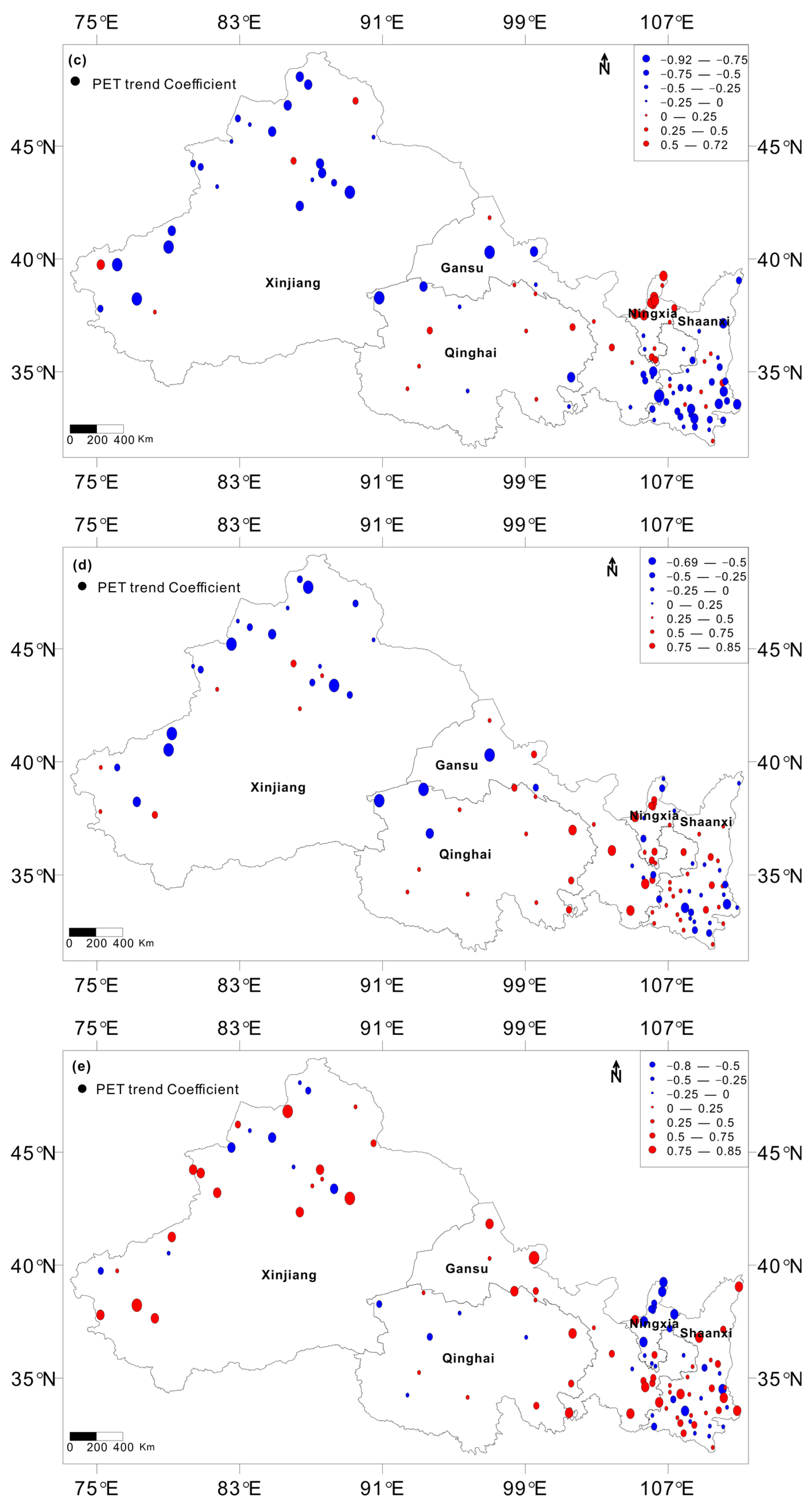
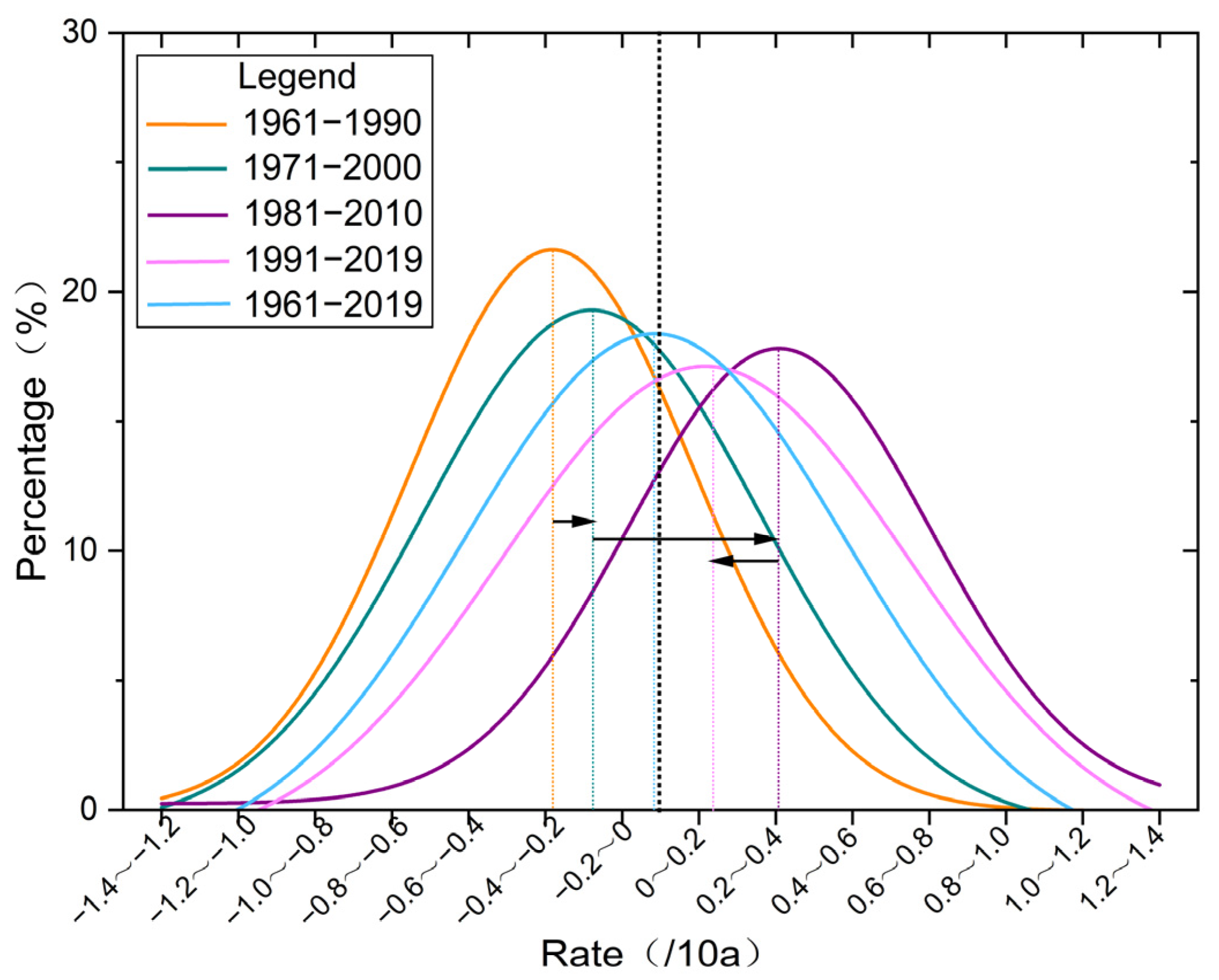
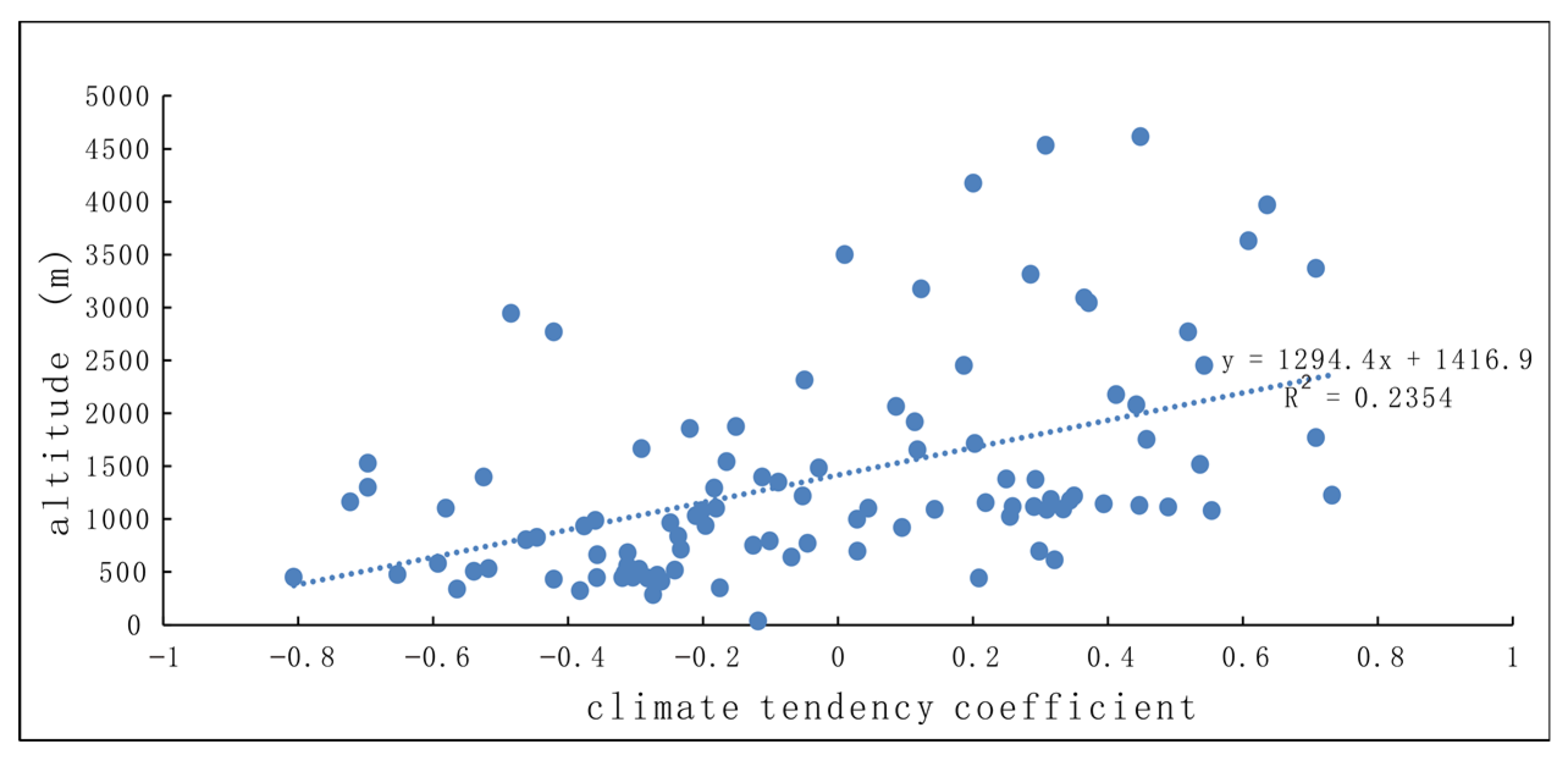
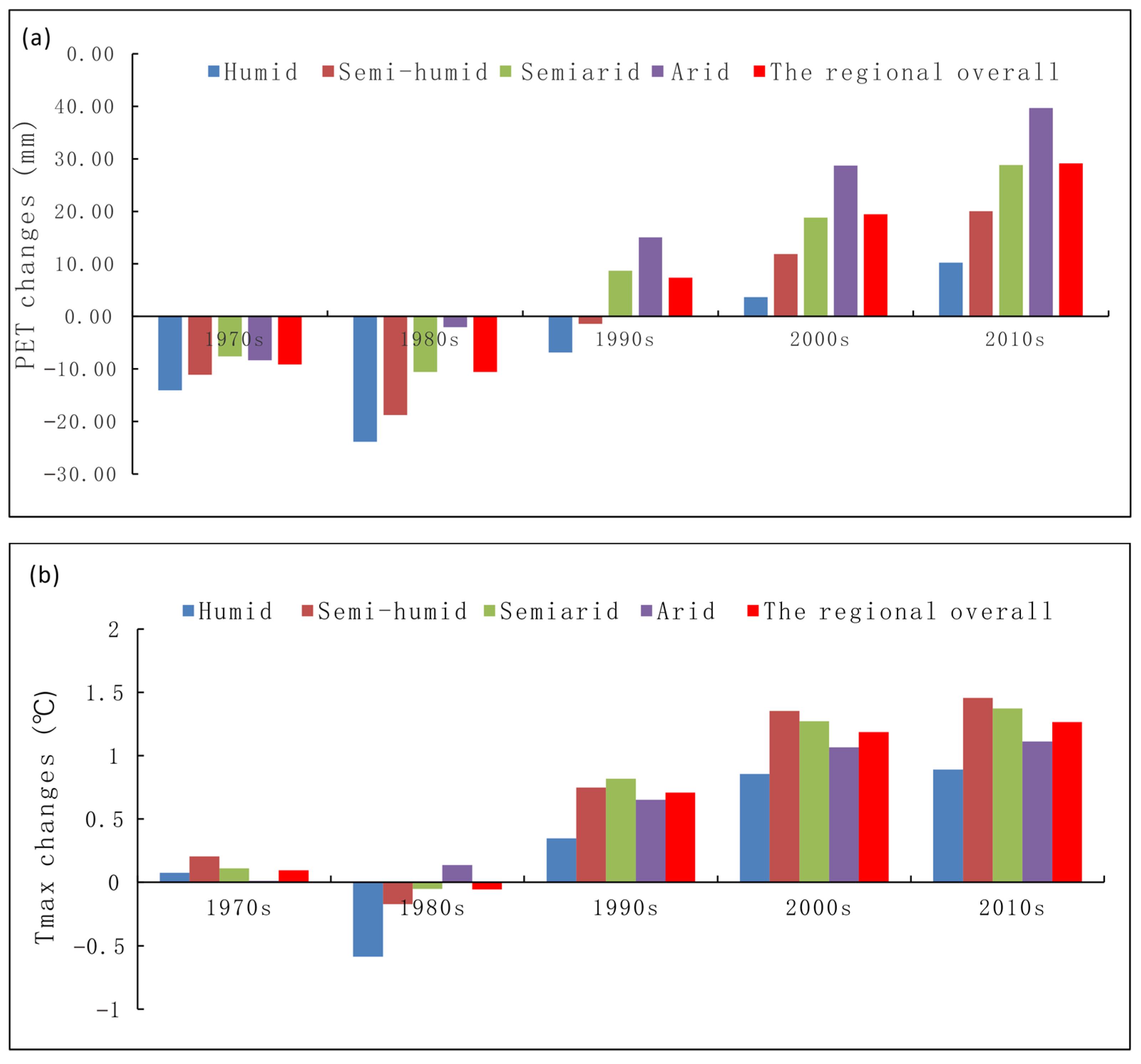
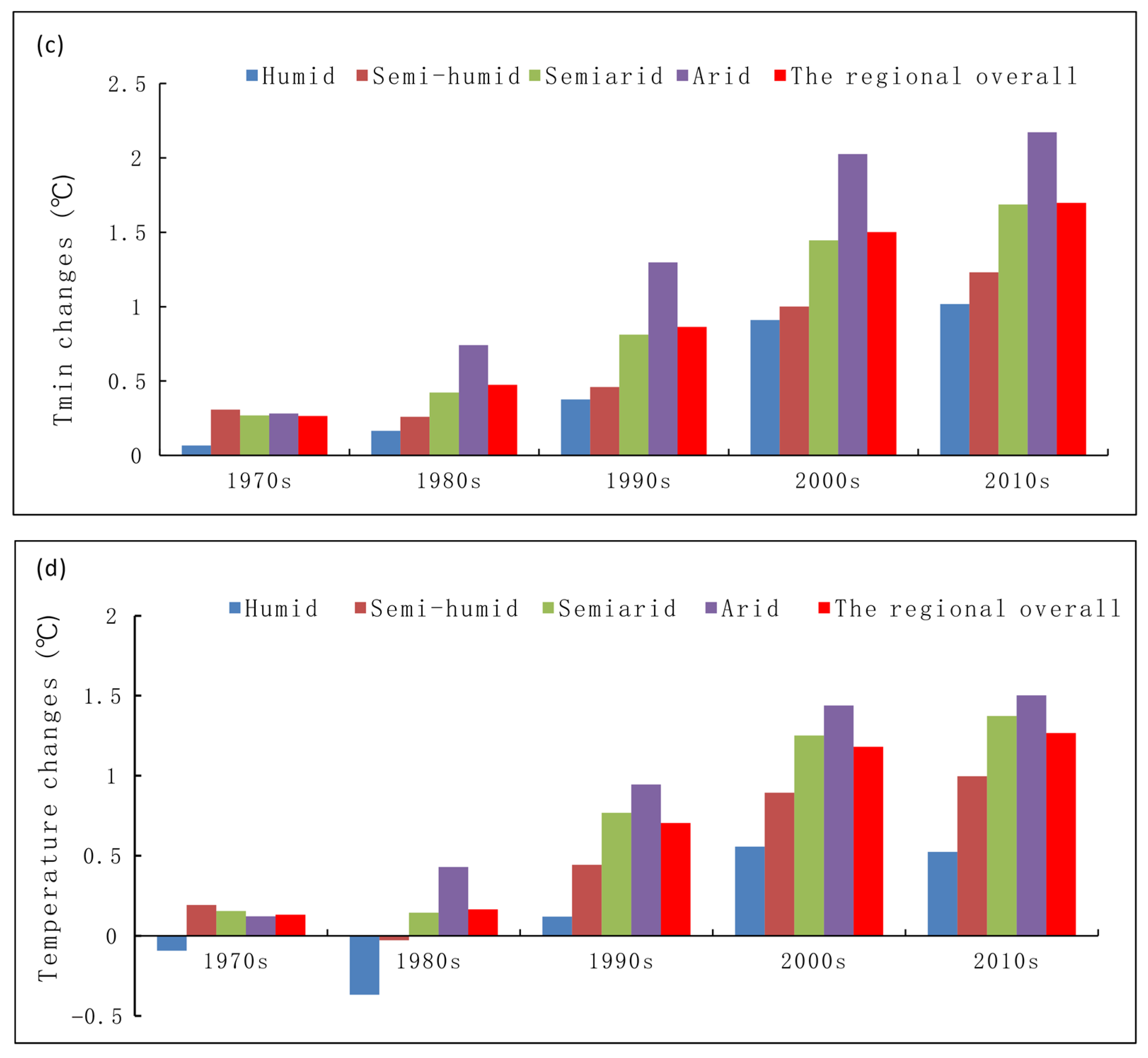
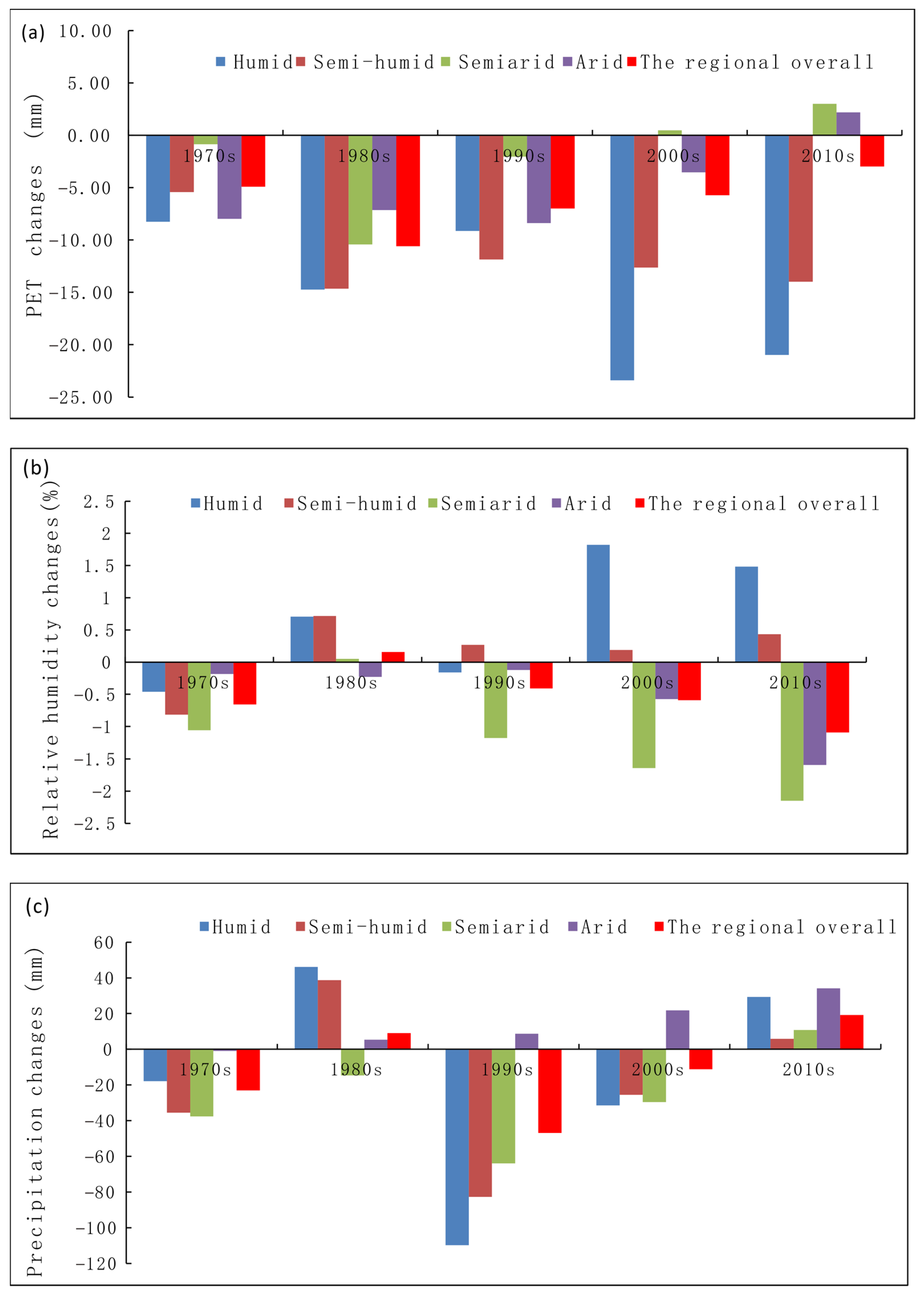
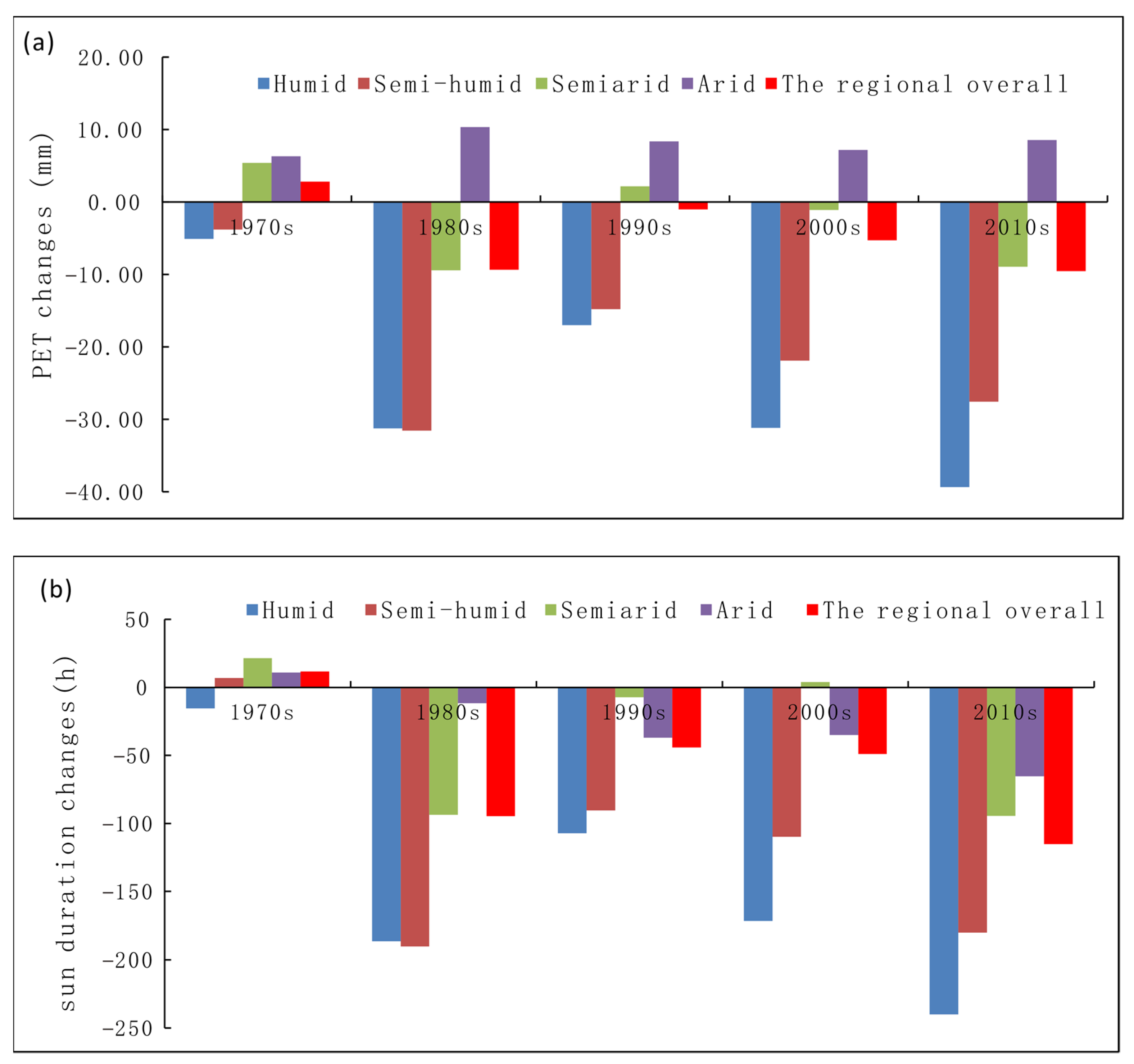
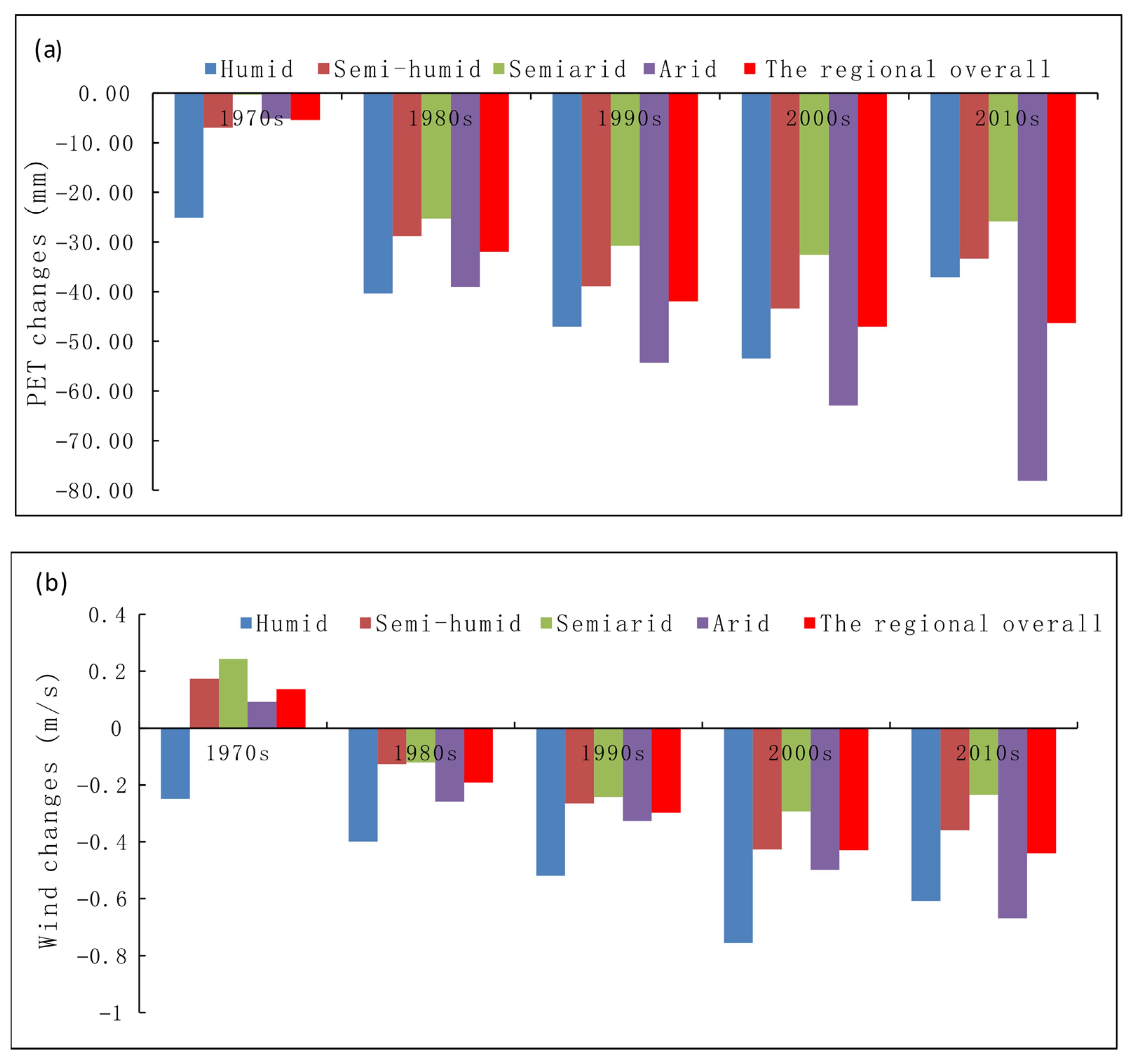
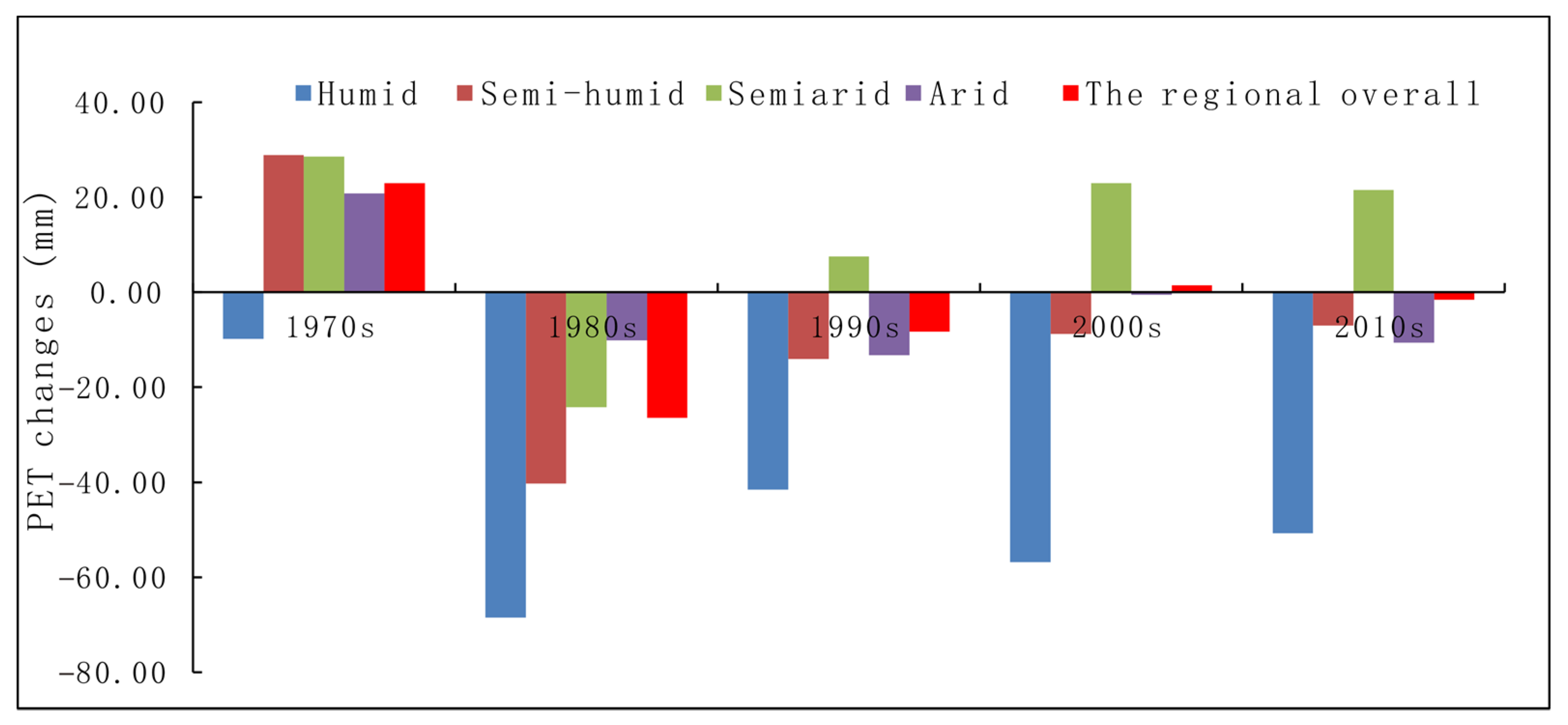
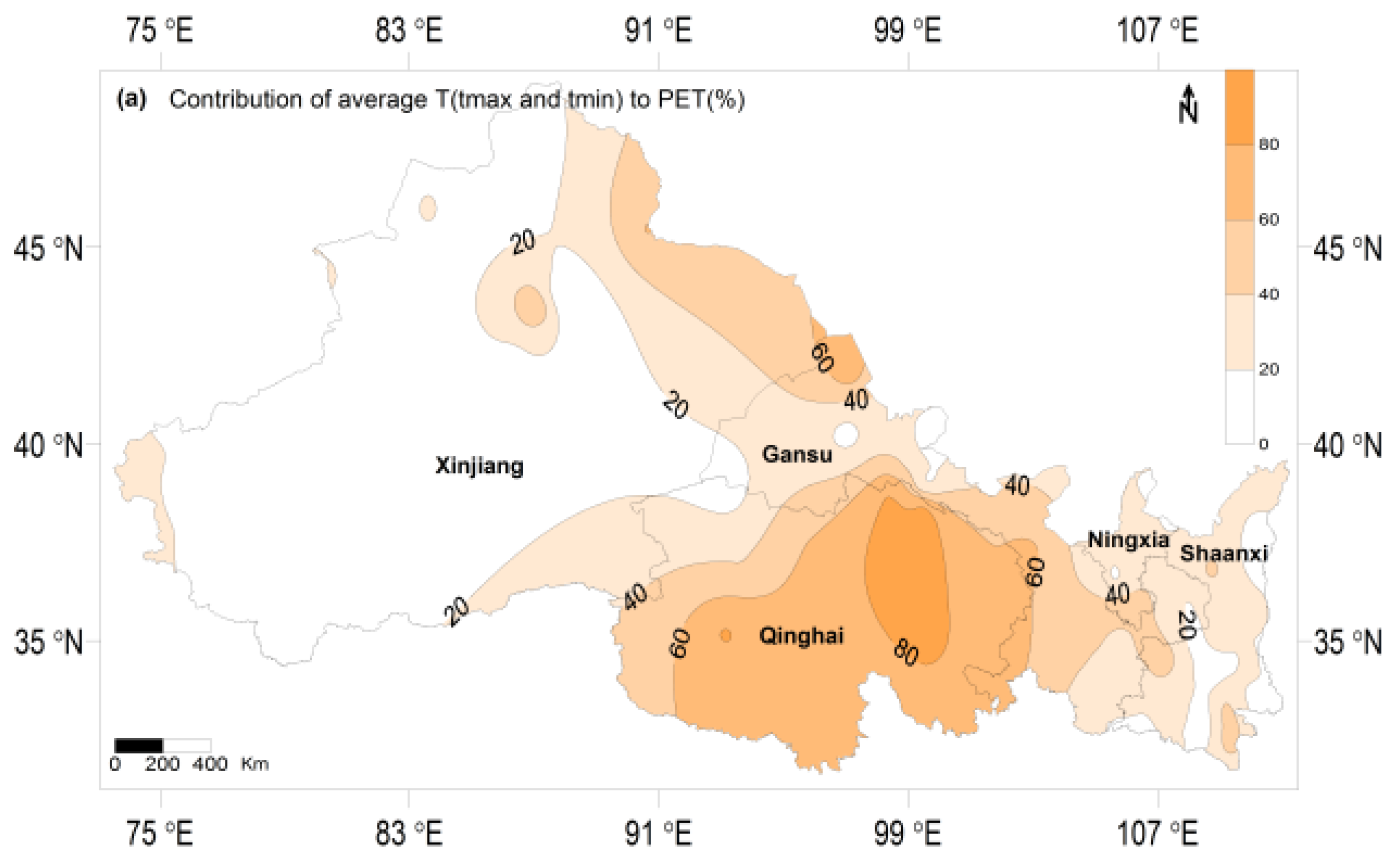
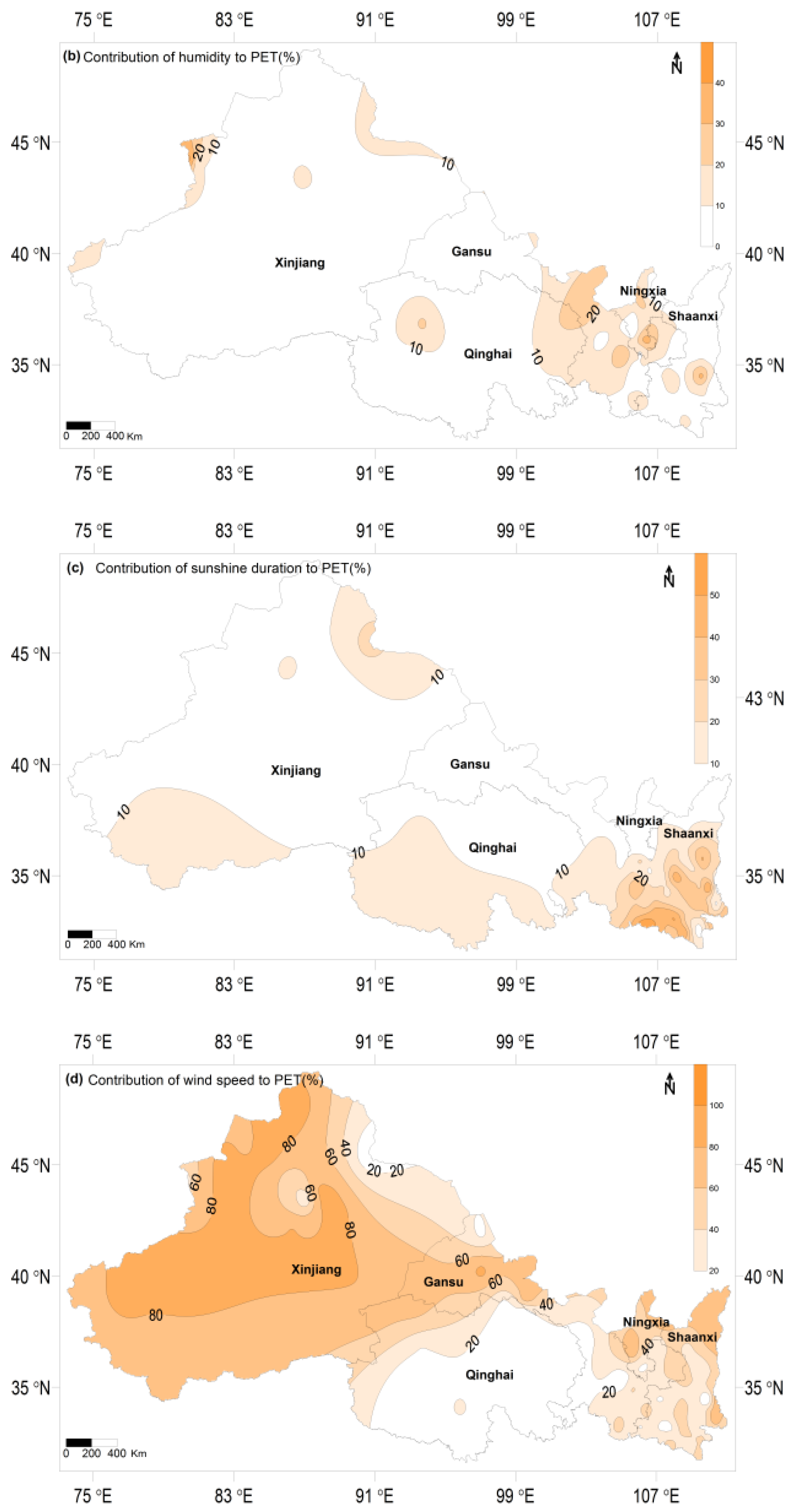
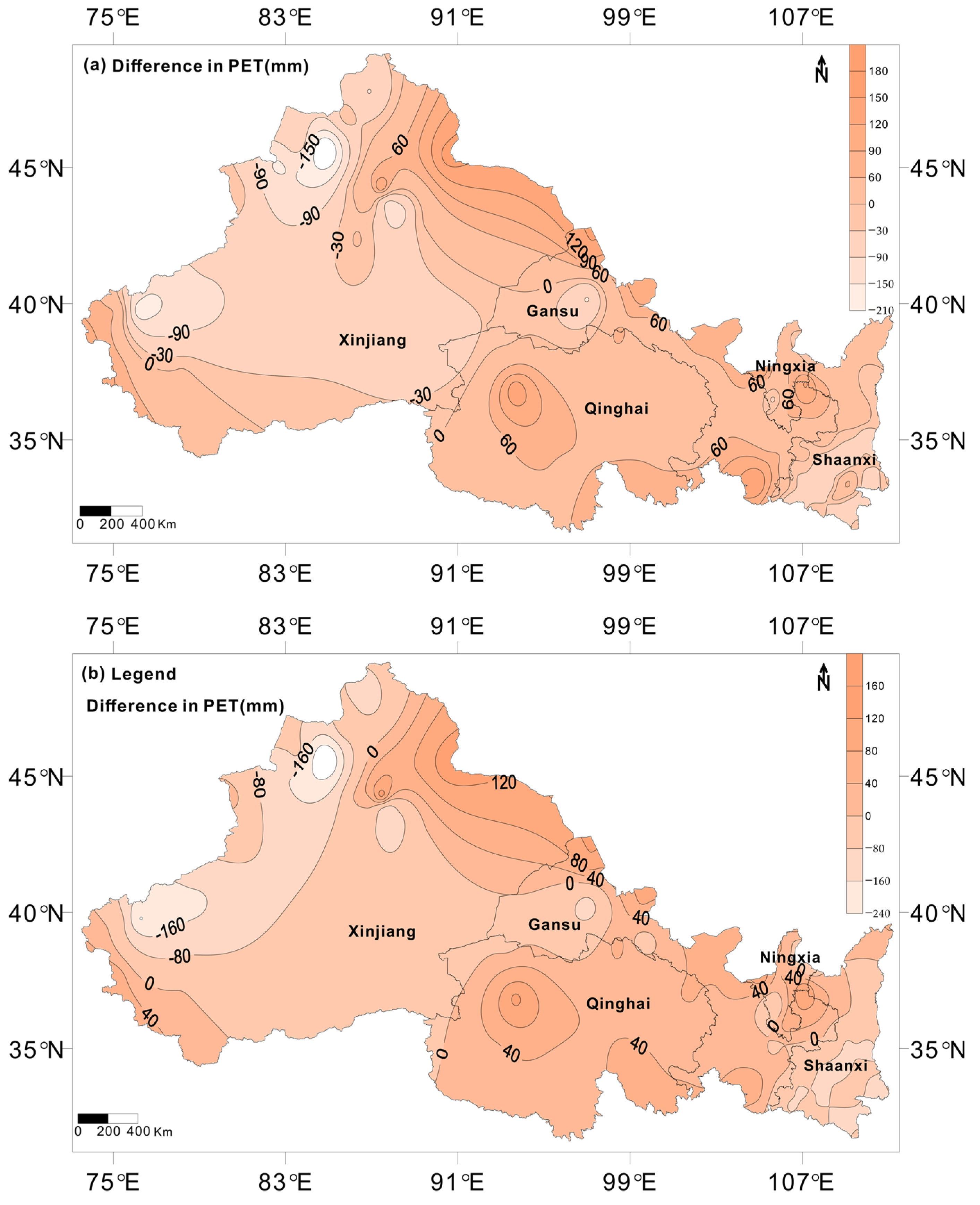
| Tmax (°C) | Tmin (°C) | Relative Humidity (%) | Sunshine Duration (h) | Wind (m/s) | PET (mm·a−1) | T (°C) | P (mm·a−1) | |
|---|---|---|---|---|---|---|---|---|
| Humid | 18.92 | 9.01 | 76.15 | 1646.23 | 1.93 | 899.10 | 13.34 | 1038.18 |
| Semi humid | 16.08 | 5.41 | 68.56 | 2053.38 | 1.99 | 899.94 | 10.15 | 746.62 |
| Semi-arid | 13.34 | 1.13 | 61.83 | 2481.71 | 2.4 | 918.70 | 6.64 | 481.56 |
| Arid | 14.10 | 0.33 | 49.70 | 2974.15 | 3 | 1126.79 | 6.87 | 124.18 |
| * The regional overall | 14.66 | 2.44 | 60.31 | 2488.57 | 2.48 | 984.34 | 8.03 | 462.35 |
| Major Cimatic Zones Affected | Regional Global Variation | |
|---|---|---|
| Tmax, Tmin | Arid, semi-arid regions | Increasing rapidly since the 1990′s |
| Relative humidity | Humid area, subhumid area | Declined markedly since the 1970′s and increased rapidly since the 1980′s |
| Sunshine duration | Humid area, subhumid area | The decrease was obvious in humid and semi humid areas, while the change was not obvious in other climate areas |
| Wind speed | Arid, humid areas | All climatic regions have been decreasing since the 1980s, the regional overall declined markedly |
Publisher’s Note: MDPI stays neutral with regard to jurisdictional claims in published maps and institutional affiliations. |
© 2022 by the authors. Licensee MDPI, Basel, Switzerland. This article is an open access article distributed under the terms and conditions of the Creative Commons Attribution (CC BY) license (https://creativecommons.org/licenses/by/4.0/).
Share and Cite
Zhu, B.; Zhang, Q.; Yang, J.-H.; Li, C.-H. Response of Potential Evapotranspiration to Warming and Wetting in Northwest China. Atmosphere 2022, 13, 353. https://doi.org/10.3390/atmos13020353
Zhu B, Zhang Q, Yang J-H, Li C-H. Response of Potential Evapotranspiration to Warming and Wetting in Northwest China. Atmosphere. 2022; 13(2):353. https://doi.org/10.3390/atmos13020353
Chicago/Turabian StyleZhu, Biao, Qiang Zhang, Jin-Hu Yang, and Chun-Hua Li. 2022. "Response of Potential Evapotranspiration to Warming and Wetting in Northwest China" Atmosphere 13, no. 2: 353. https://doi.org/10.3390/atmos13020353
APA StyleZhu, B., Zhang, Q., Yang, J.-H., & Li, C.-H. (2022). Response of Potential Evapotranspiration to Warming and Wetting in Northwest China. Atmosphere, 13(2), 353. https://doi.org/10.3390/atmos13020353






